
© Angela Piazza/Caller-Times/USA TODAY NETWORK
This week’s 40-man roster deadline was less eventful than usual (we only had one trade on deadline day), but as always, a number of young players became big leaguers in a certain sense, and teams had no choice but to indicate what they think of lots of fringe prospects who they either did or did not choose to roster. This day of clerical activity is the culmination of the efforts of the players themselves, the people in player development who have helped turn them into big leaguers, and the scouting and decision-making portions of each org that put their stamp of approval on the prospects. Is any one move here as impactful as signing a Yoshinobu Yamamoto or a Matt Chapman? No, but when your favorite team experiences a rash of injuries in June, whether or not they have the depth to scrap and compete is often dictated by the people and processes that surround this day. I’m more focused on analyzing roster depth, fit and flexibility in this space than on scouting players (especially when they’re star prospects you already know well). I’ll have a separate post on the National League.
Baltimore Orioles
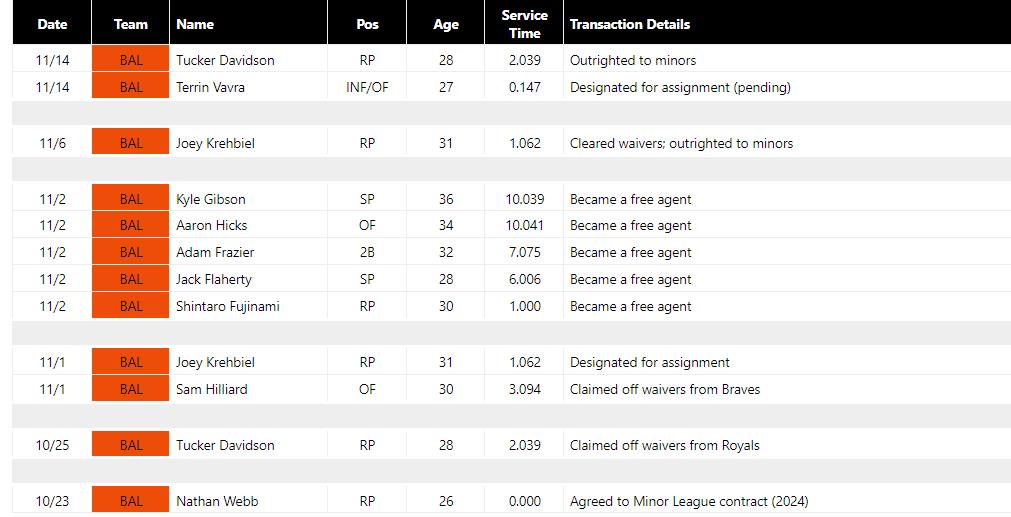
The Orioles didn’t add anyone to their 40-man roster from within the organization ahead of the deadline. Claiming Sam Hilliard from Atlanta added to an already deep group of lefty-hitting corner outfielders who will compete for time next spring, including Heston Kjerstad, Colton Cowser and Kyle Stowers. Mike Elias told me at GM Meetings, “I think we do have a ton of playing time available for a fourth person and it’s up in the air who that’s going to be right now primarily as of this time. I do think we have a job open even though our primaries (Austin Hays, Cedric Mullins, Anthony Santander) are in place.”
It’s plausible Santander (who will hit free agency next offseason), Ryan O’Hearn (an Arb-3 player this offseason) or maybe even Mullins (who was often the subject of Marlins trade inquiries during the Kim Ng era) could still be moved this offseason and create more opportunity for playing time than is currently available. Baltimore still has four open 40-man roster spots as we approach Winter Meetings.
Boston Red Sox
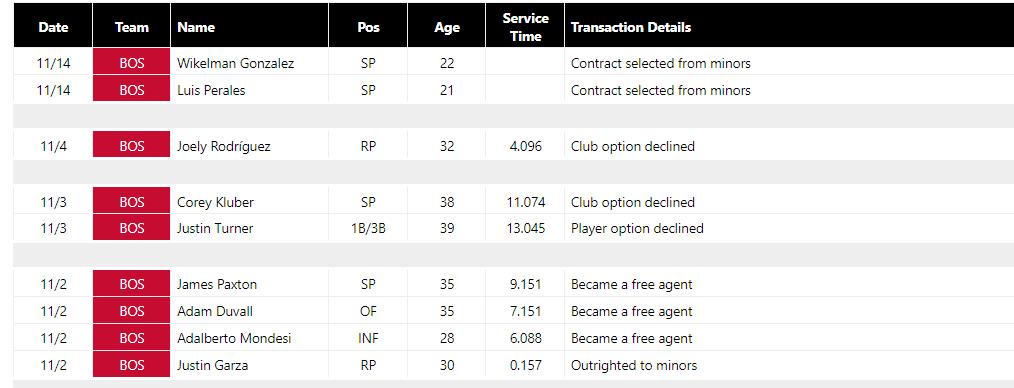
More interesting than what Boston did Tuesday is what they didn’t do. They arguably had the biggest roster crunch in baseball, with nearly a dozen potential additions and eight or so current 40-man occupants who I’d consider on the roster bubble. Young righties Luis Perales (whose fastball has monstrous vertical carry) and Wikelman Gonzalez (plus secondary stuff) are both young and raw enough to expect they’ll spend their first year on the 40-man entirely in the minors. Prospects Grant Gambrell, Ryan Fernandez, Angel Bastardo, Chih-Jung Liu, Shane Drohan, Juan Daniel Encarnacion, Eddinson Paulino, and Allan Castro all had interesting cases to be added versus not. The relief-only guys (Gambrell, Fernandez) are lower-impact types who were probably safe to leave unprotected, Drohan’s rough second half hurt his chances of being rostered, and most of the rest of the candidates are extremely young and unlikely to stick on someone else’s active roster next spring. Especially as more and more teams tend to err on the side of not adding players this time of year, more and more players fill the potential Rule 5 Draft pool and the chance any one of your team’s guys gets popped in the draft drops through the sheer volume of alternatives. Liu (sitting 95 mph with a plus breaking ball and average split as a starter) could be vulnerable in the Rule 5, especially if teams think his stuff will tick up in relief.
Chicago White Sox
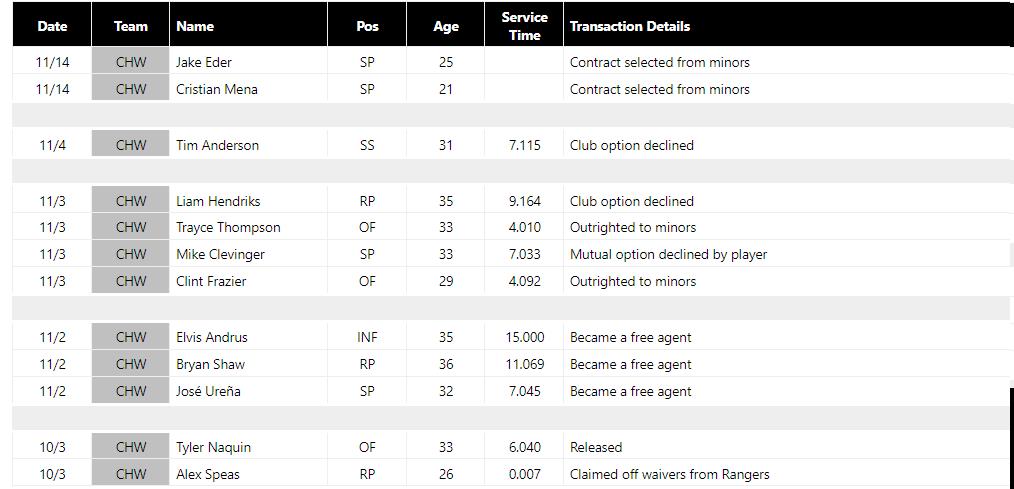
Lefty Jake Eder was acquired from Miami for Jake Burger at the trade deadline. A former Top 100 prospect, his arm strength hasn’t totally returned coming off of Tommy John, and he sat 92-94 mph throughout the regular season and during the Arizona Fall League. His breaking ball remains excellent and Eder has starter-quality changeup feel (though that pitch isn’t very nasty from a stuff standpoint), so he’s still a fair starting pitching prospect, but I don’t expect him to kick down the door in 2024 unless his arm strength fully returns. Cristian Mena also has a plus breaking ball and plus changeup feel, but he has a below-average heater. He’s only 20 and pretty likely to spend his first season on the 40-man entirely in the minors as the White Sox cycle through fringe players from other rosters looking for sticky reclamation projects who might be part of their next good team.
The “post-hype” parade here has already begun with the likes of Deivi García, Luis Patiño, Touki Toussaint and others poised for 2024 roles. The key prospect-related developments to watch for in 2024 will be how the young 40-man infielders play given a more thorough and extensive big league look. Lenyn Sosa, José Rodríguez and Romy Gonzalez are all talented, but each has significant chase-driven bust risk. Bryan Ramos deserves an extended opportunity at some point during the second half of the season to tee him up for Opening Day 2025. Especially with Tim Anderson no longer on the team, this window between now and when Colson Montgomery is ready is important for determining who else from this group can actually contribute.
Cleveland Guardians
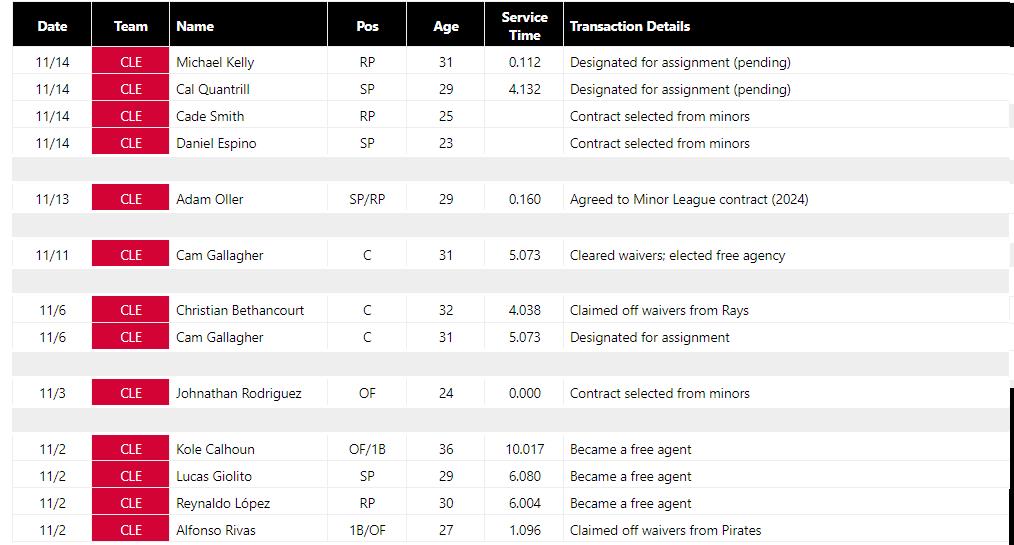
This year was less crunchy than things tend to be for the Guardians, who claimed light-hitting first baseman Alfonso Rivas from Pittsburgh and upgraded their backup catcher spot by claiming Christian Bethancourt from the Rays. From within, they added 23-year-old power-hitting Puerto Rican outfielder Johnathan Rodriguez, reliever Cade Smith (nasty rise-and-run mid-90s fastball, violent/deceptive delivery that’s hard to repeat) and injured Top 100 prospect Daniel Espino. Espino absolutely would have been taken in the Rule 5 Draft had he been left unprotected. When he was last healthy, he was working with some of the nastiest stuff I’ve ever seen and a team would have been happy to let him finish rehab on their 60-day IL and pitch in relief for the rest of the year to keep him on the active roster. General manager Mike Chernoff told me at the GM Meetings that Espino is rehabbing in Goodyear and has begun a throwing program. Considering the way they tend to behave from a roster management standpoint (Chernoff also told me, “You never want to make a decision earlier than you need to with prospects and you want to keep lanes of opportunity open.”), I’d expect George Valera and/or Jhonkensy Noel to get a big league opportunity before Rodriguez, who I’m skeptical will hit enough to be a long-term player of import.
Detroit Tigers

Wilmer Flores‘ velocity is down considerably compared to a year ago (more 92-94 mph than the 95-96 of last AFL), but he still has the repertoire depth and command to start. His breaking ball quality is excellent. Keider Montero still has command-related relief risk but held 94-96 mph all season under an approximately 130 inning workload. Dillon Dingler is the fourth catcher on the 40-man. Detroit now has a full 40-man, which means any further additions via free agency or trade will need to come with an accompanying move to clear a spot. Their four-man catching group (especially Donny Sands and Carson Kelly), optionless reliever Miguel Diaz, and bench bats Tyler Nevin and Andy Ibáñez would seem to occupy their roster bubble right now.
Houston Astros
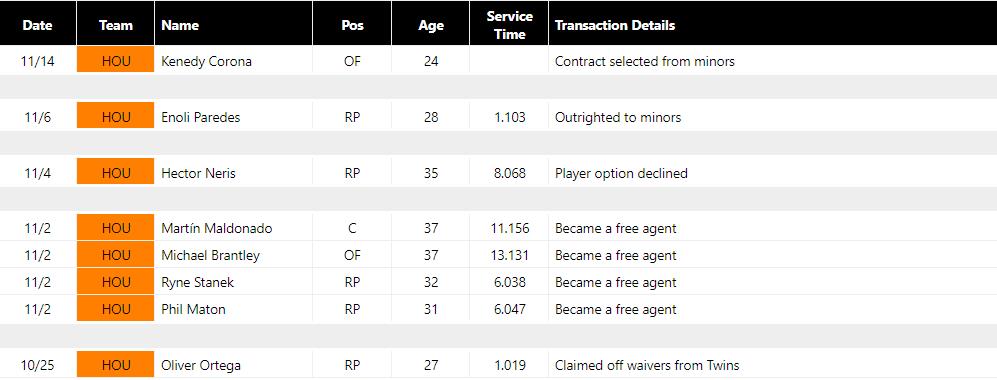
There wasn’t much action here, in large part because Houston’s system appears pretty bare at the moment. Kenedy Corona packs an impressive punch for a hitter his size, and his ability to play a quality center field compared to the rest of Houston’s major league options gives him a shot to win playing time if the Astros don’t add to their outfield mix this winter. It seemed like Dusty Baker wasn’t enamored with some of the team’s center field options; were he still managing, I’d consider the possibility for turnover at that position to be greater.
Kansas City Royals

Will Klein (upper-90s velo reliever) and Tyler Gentry (ideally a lefty-mashing platoon outfielder) were added to the Royals’ now completely full 40-man. I think some of Kansas City’s unprotected relievers present interesting Rule 5 opportunities, especially if teams can identify low-hanging developmental fruit among them. Christian Chamberlain, Jacob Wallace and even Jonah Dipoto have good relief stuff, and it’d be interesting to see what an org with a better recent track record of developing pitching could make of them or a healthy Asa Lacy. Many of the prospects the Royals have traded for during the last couple of years (T.J. Sikkema, Beck Way, Wallace, Devin Mann, CJ Alexander) were left unprotected, which is frustrating when big leaguers were sent packing to acquire those guys. Is this a talent identification issue, a player development issue, or both?
Los Angeles Angels
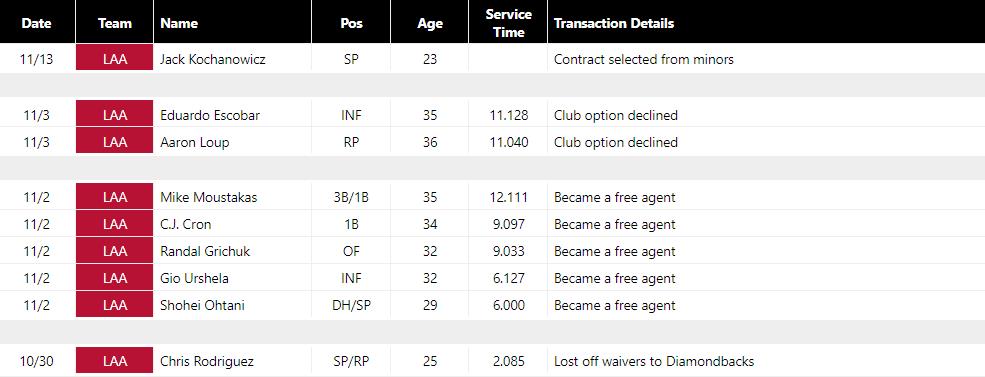
There’s not much to discuss here. Jack Kochanowicz dropped his arm slot and found nearly three ticks of velo in 2023. He’s likely to be up and down throughout 2024.
Minnesota Twins
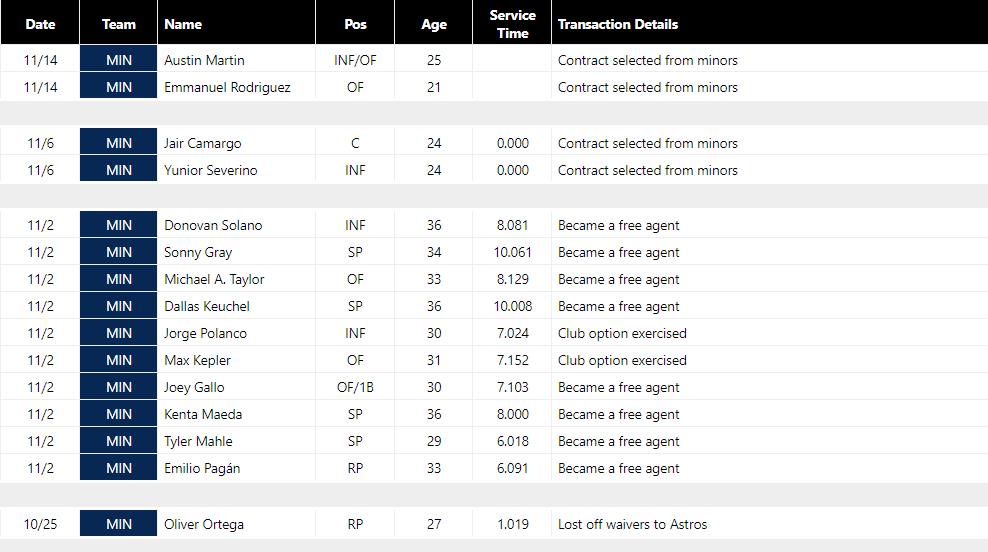
I think Emmanuel Rodriguez, who is a lock to be a top 100 prospect this offseason despite his hit tool issues, has a chance to break camp as the Twins’ starting center fielder given Byron Buxton’s persistent injury issues. He’s a big league-quality defender right now. That would allow Willi Castro (currently the center fielder on our Depth Chart) and Nick Gordon to play dynamic, multi-positional roles, which the Twins sorely lacked in 2023.
The other additions here are bat-only guys. Austin Martin‘s feel for contact (91% Z-contact rate at St. Paul in 2023) and Yunior Severino’s power make them luxury upper-level depth, but they’re both limited on defense. Jair Camargo, who was part of the Kenta Maeda/Brusdar Graterol swap, is a thicc, power-hitting tough guy catcher with below-average hands and arm accuracy. Camargo’s 2023 hard-hit rate (50%!) and barrel rate (17%) would both have paced big league catchers this season, but his contact rates rate near the bottom of the position. He’s not about to usurp Ryan Jeffers on pure talent, but if injuries force him into action he’s going to be a dangerous bottom-of-the-order hitter. With these additions, the Twins appear to have the depth to weather injuries to their position player group.
New York Yankees

The Yankees now have five catchers on their 40-man roster. Even though I’d consider Agustin Ramirez a purely developmental addition at this stage (his defense is raw in most aspects), I’d still expect some movement from this group during the offseason unless Austin Wells is ticketed for a ton of DH duty next year. I don’t think Clayton Beeter is a great long-term starting option but with Yoendrys Gómez out of options and Luis Gil’s workload likely to be light coming off of surgery, the Yanks only have so many optionable starters currently on the 40-man. I buy that Will Warren, Drew Thorpe, and others could be ready during the season and simply be added when bottom-of-the-roster relievers fall off.
Oakland Athletics

I really liked what I saw from Royber Salinas during the Fall League and think he’s going to be an offseason Top 100 prospect for me, likely to seize a rotation spot out of the gate in 2024. He has a riding mid-90s four-seamer, a one-seam sinker, two distinct plus breaking balls and a fair changeup in his bag at age 22. Yes, he’s a husky guy, but he’s super smooth and loose, and I love that he can get ahead of hitters with his breaking stuff during outings when his fastball command isn’t there. Brady Basso is a lefty with a cut/rise low-90s fastball and a vertical breaking ball that plays off of it; a cutter rounds out a backend repertoire. Darell Hernaiz will likely spend 2023 entirely in the minors trying to become more selective. Lazaro Armenteros, once among the most intriguing amateur prospects in Latin America and a $3 million signee, cut his strikeout rate quite a bit in 2023 and was added to Oakland’s roster. I’m skeptical that he’ll hit enough against big league pitching to get to his power.
Seattle Mariners
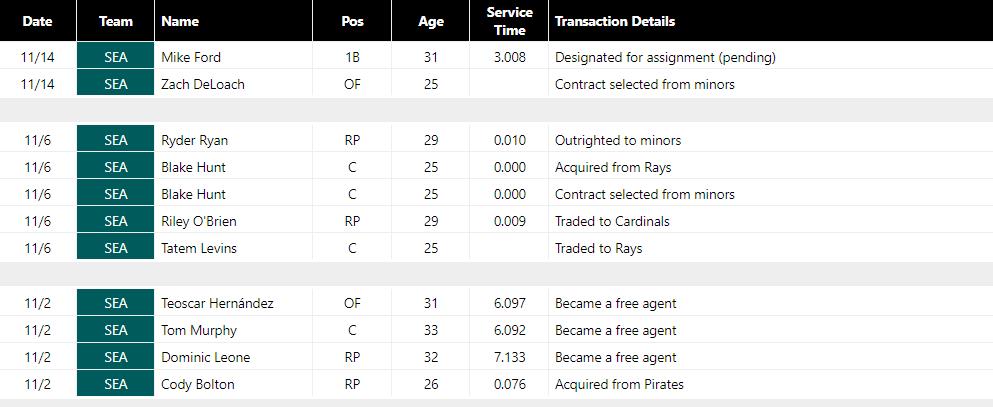
Seattle’s most significant move came nearly two weeks ago when they traded with Tampa Bay for catcher Blake Hunt, who is currently in line to be their backup backstop. He’s a former top 100 prospect whose hit tool has put him more in the backup bucket. He can still pull a mistake breaking ball with power, but he’s rosterable more because of his solid all-around catching defense. He’ll hopefully provide more stability than the Mariners enjoyed last season when they were shuffling through several different options amid Tom Murphy’s injuries.
Of all the lefty-hitting Mariners vying for corner outfield reps, newly-added Zach DeLoach has the second-most raw power behind the incumbent, Dominic Canzone. He rates toward the bottom of the group from a defense standpoint. This is an extremely crowded field made up of DeLoach, Canzone, Sam Haggerty (realistically an outfield-only player at this point), Cooper Hummel, Cade Marlowe, Taylor Trammell, and Jonatan Clase. Canzone’s power and Clase’s speed and defensive ceiling are special tools even when compared to other big leaguers; the rest of this group is lacking in this regard and has more of an upper-level depth vibe. In fact, I think Spencer Packard, who didn’t yet require roster protection, might be the best pure hitter of this entire bunch, and could be a better option for regular playing time than any of the others by midseason. The bottom of the position player side of Seattle’s roster still needs to improve.
Tampa Bay Rays
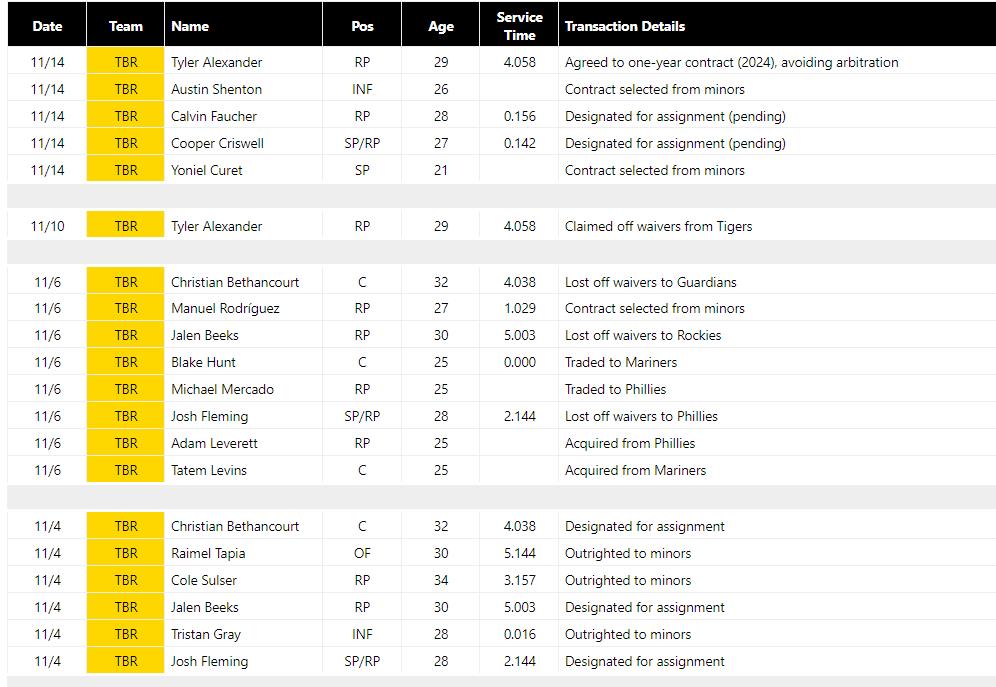
The Rays offloaded most of their upper-level catchers during the last several weeks (Francisco Mejía is a free agent, Blake Hunt was traded, Christian Bethancourt was waived) and have just one backstop currently on their 40-man. René Pinto looked like a deer in headlights during Tampa Bay’s postseason face plant, and I consider him and Alex Jackson poised to do battle for backup duty next spring. Surely the Rays will add at least one established big leaguer to their mix during the offseason, be it via free agency or in trade.
Any crunch the Rays might have experienced on deadline day was alleviated by Michael Mercado (trade) and Josh Fleming (claimed off waivers) heading to Philly, as well as the Hunt deal. Their 40-man is full after the additions of 21-year-old righty Yoniel Curet (likely a reliever in the end, but he has absurd in-zone fastball utility) and 25-year-old power-over-hit 1B/3B(ish) Austin Shenton. There’s a ton of logical trade speculation surrounding Tyler Glasnow, whose contract was backloaded to pay him $25 million next season, and a few young impact players (Curtis Mead, Junior Caminero) are poised to usurp potentially moveable veterans like Manuel Margot and/or Harold Ramírez (I would have said Yandy Díaz 12 months ago, but he hit too well to move). The Rays roster is likely rather unsettled at this stage.
Texas Rangers
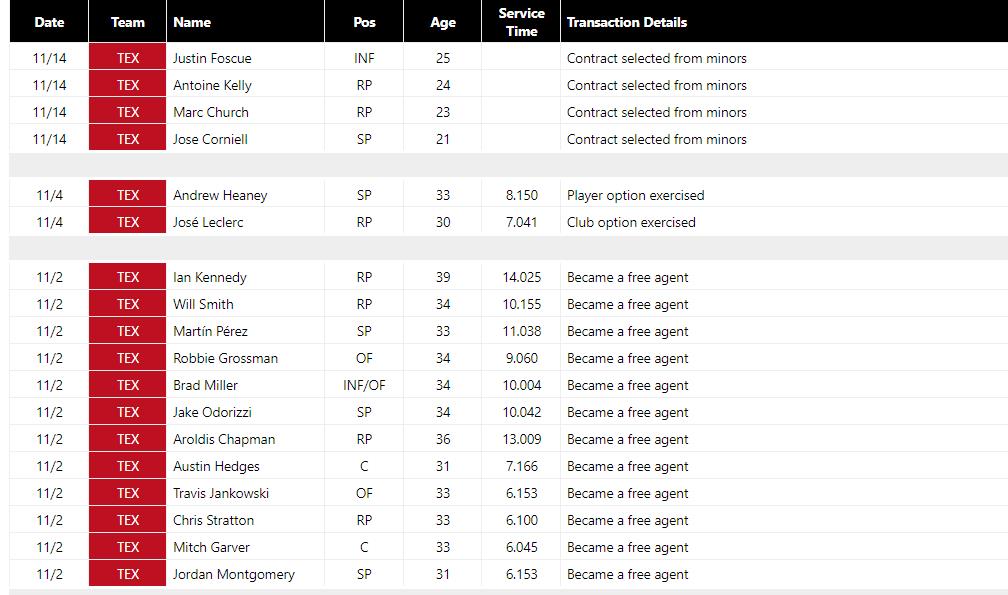
The champs added four players to their roster on Tuesday. Justin Foscue (premium feel for contact, fringe-average power) is a bad defender but if Nathaniel Lowe continues to struggle like he did late in 2023, we might see Foscue replace him in 2024. Pure relievers Marc Church and Antoine Kelly stand a chance to seize late-inning work next year if components of Texas’ bullpen struggle again. Last year, I wrote about why it might be that the majors have so few Latin American starting pitchers, chiefly concluding that their 40-man timelines (which often have the best ones rostered at age 20) compress their development in a way that makes it tougher for them to develop a starter’s skills. A talented 20-year-old may not hone his craft enough to start during his first couple of option years and be forced into the bullpen. Jose Corniell’s command is already so sharp that he stands to buck this trend. He has very precocious feel for a promising three-pitch mix (sitting 94, data-friendly slider, advanced changeup usage), similar to Dane Dunning from a style, command and body/athleticism standpoint.
Toronto Blue Jays
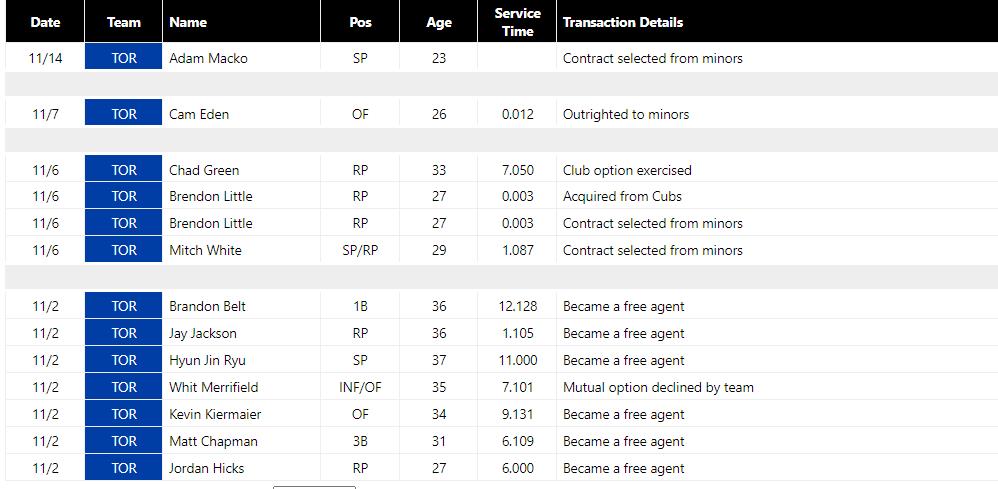
I think the Blue Jays still need to sort out their 2B/3B situation, but I like the sheer number of candidates who are already on the roster. I was not on Davis Schneider during my last Blue Jays prospect writeup and I’m still pretty skeptical that he can have a sustained long-term role, let alone produce like he did before his end-of-season swoon. He has a great idea of the zone and does fairly well executing a pull-heavy, mistake-crushing approach, but you can get him out if you execute at the belt, and Schneider’s bulkiness makes me apprehensive about his long-term defensive fit. I’m more bullish about the Leo Jimenez/Orelvis Martinez/Addison Barger contingent (Barger looks more like an outfielder to me now) than I am the 2B/3B types currently slotted onto the big league roster on Toronto’s Depth Chart.
Source
https://blogs.fangraphs.com/40-man-roster-deadline-reaction-and-analysis-american-league/
 Backyard GrillingWeekend WarriorsAdvice from DadBeard GroomingTV Shows for Guys4x4 Off-Road CarsMens FashionSports NewsAncient Archeology World NewsPrivacy PolicyTerms And Conditions
Backyard GrillingWeekend WarriorsAdvice from DadBeard GroomingTV Shows for Guys4x4 Off-Road CarsMens FashionSports NewsAncient Archeology World NewsPrivacy PolicyTerms And Conditions
